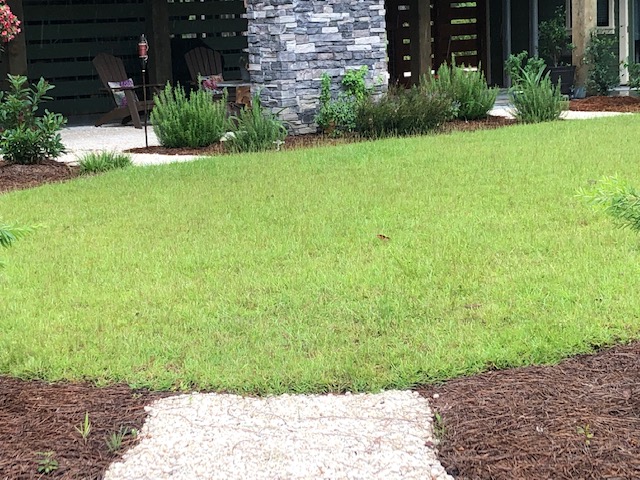
by Stephen Greer | Jul 1, 2021
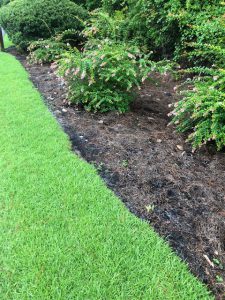
Photo Courtesy: Stephen Greer
Lawn areas come in all sizes and shapes. Some are large open expanses providing long views and others are smaller versions surrounded by shrubs and trees creating a more private and secluded setting. There are a number of reasons for reducing the size of a lawn with some coming into play with your decisions. A home lawn is often an important part of the landscape that provides a place to play outdoors from picnicking, tossing the ball to taking a quite stroll.
Maintaining a healthy lawn is important to an overall performance of this part of the landscape. Several factors are involved in the success in keeping a strong and resilient lawn. Understanding the needs of a grass to remain healthy involve soil testing to address soil pH and nutrient needs plus water challenges. Misuse of fertilizer and over irrigation can be costly to you and to the overall health of the lawn. These decisions can lead to reducing lawn size to managing cost or removing underused areas.
There are big benefits to reducing your lawn from saving time in mowing, trimming and other manicuring needs to saving energy costs involving the lawn mower not to mention reducing pollution from the mower or weed eater. The reduced amounts of pesticides needed to manage weeds and disease to the lawn saves time and money.
Another way to look at the reducing the size of our lawn is there will be more space for expanding plant beds and potential tree placement. These settings increase the opportunities for a more biodiverse landscape providing shelter, protection and food options for birds and other wildlife.
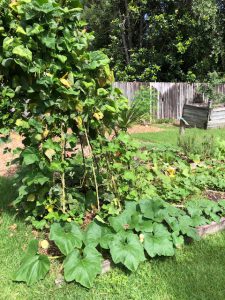
Photo Courtesy: Stephen Greer
The lawn can serve as a transition space that leads from one garden room space to another, while still offering a location to bring the lawn chair out to enjoy all that is around your lawn. Lawns and the landscape are ever changing spaces, especially as your trees and shrubs grow and mature to sizes that can directly impact the lawn performance. Often levels of shade will diminish edges and other areas of the lawn. This often will define the reduction of the lawn size moving going forward. Just remember that lawns and landscapes occupy a three-dimensional space involving the horizontal, vertical and overhead spaces. Just look around and think about what is best for you, your family and the setting.Are you more interested in developing other parts of the landscape? With many of us spending more time at home over the last year plus it gave time to think about the outdoor areas. Growing our own vegetables may be a new or expanding part of the landscape with the use of raised beds or interplanting into the existing landscape. Gardening can assist in reducing stress while at the same time providing that fresh tomato, lettuce, herbs and other fun healthy produce.
What ever your decisions are enjoy the lawn and landscape. For additional information, contact your local University of Florida IFAS Extension office located in your county.
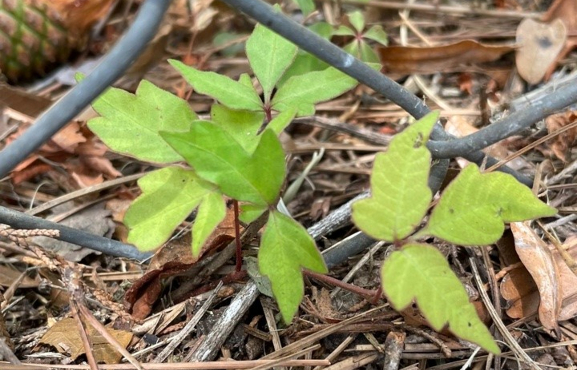
by Pat Williams | Jul 1, 2021
We work very hard to maintain our gardens and then we look up and vines are growing 20′ into the trees. I get asked frequently “what is growing up my trees?” My first answer is “probably the same things growing on your fences.” These include Smilax species, commonly called catbrier or greenbrier, Vitis rotundifolia, referred to as wild muscadine grape, Parthenocissus quinquefolia or Virginia Creeper, and the one to be most careful with, Toxicodendron radicans, known by many as Poison Ivy.
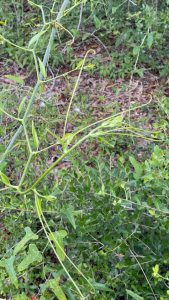
Spring growth on the Smilax vine.
Smilax is a native vine that grows quickly in spring and all summer. There are 12 species in Florida and 9 species commonly found in the Panhandle. Besides being armed with thorns on their stems and some leaves, Smilax spreads by underground stems called rhizomes. If you choose to ignore it, some species can cover your trees and the stems become woody and hard to remove. This vine also produces fruit and seeds are dispersed by birds all while the underground rhizomes are spreading under your lawns and gardens.
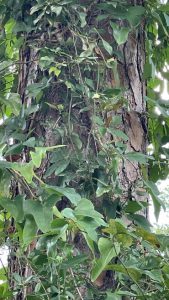
Smilax can quickly cover a tree trunk.
Removal can be difficult and mowing the vines only encourages more growth. When trying to remove by hand, wear heavy leather gloves and some eye protection because of the thorns. Cut the stems about three feet above the ground which allows you some stem to pull on to bring it out of your tree. You also then have a handle to pull and try to remove some of the rhizome from underground. Digging rhizomes is time consuming, but gives you piece of mind that they won’t come back immediately. Our family actually harvests the new shoots in spring and we use them like asparagus.
Wild muscadine grape is also native and difficult to remove. Most of the vines in nature are male and only produce by runners along the ground and then grow upwards. The female vine can produce 4-10 grapes in a cluster and then reseeds itself.
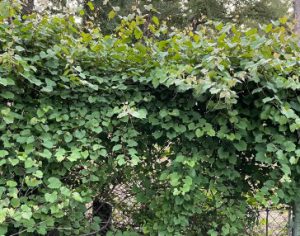
Wild muscadine grape covering a fence.
Wild grape completely covers plants and eventually the plants underneath can die. There are no thorns to contend with when removing wild grape, it is just time consuming, especially if it has taken over your fence or natural areas.
Virginia Creeper is a native vine, still considered a nursery plant in some areas of the country, and has bright red fall color.
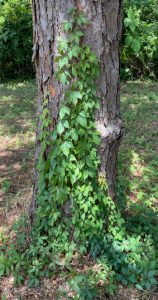
Virginia Creeper climbing a tree trunk.
It is most often confused with poison ivy because of having five leaflets per leaf whereas poison ivy only has three leaflets per leaf. It spreads by seeds, runs along the ground, and is the easiest of these four vines to remove from your property.
Poison Ivy is a native vine distinguished by its three leaflets with the individual leaflets getting up to 6″ long. This vine spreads by seeds and underground rhizomes. What makes removal of this vine difficult is the urushiol oils which causes the skin rashes and blistering.
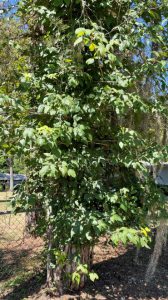
Poison ivy covering a tree trunk.
Care must be taken to cover up all skin and I recommend wearing waterproof clothes versus cotton which can absorb the oils and transfer them to your skin. Under no circumstances should these vines be put on the burn pile, the oils can become airborne and then you can inhale them.
Here are a few helpful tips when battling these native vines. First have patience and be dedicated, this removal will not happen over night. It may take a year or two to rid your property of the original vines. Be diligent though, because birds will continually land in your trees and deposit more seeds to get a fresh start. Try to remove vines when they are young and just beginning to climb your trees and fences. If you know you don’t have the time or energy to remove the vines from all your trees, at least cut the vines close to the ground to reduce flowering and new seeds. Be careful with poison ivy because falling leaves still contain oils. Once the vines start to have a new flush of growth, spray a non-selective herbicide on new growth and you should have good results. Lastly, remember one person can make a difference in trying to reduce the number of nuisance vines in our communities.
Here are some sited references to help with your removal tasks. Key to Nine Common Smilax Species of Florida. https://edis.ifas.ufl.edu/publication/fr375. Smilax is a Vine that can be Difficult to Control. http://blogs.ifas.ufl.edu/wakullaco/2017/04/21/smilax-is-a-vine-that-can-be-difficult-to-control/. The Muscadine Grape (Vitus rotundifolia Michx.) https://edis.ifas.ufl.edu/publication/hs100. Muscadine Grape Vines: Difficult to Control in Your Landscape. http://blogs.ifas.ufl.edu/wakullaco/2017/03/24/muscadine-grape-vines-difficult-to-control-in-your-landscape/. Parthenocissus quinquefolia: Virginia Creeper https://edis.ifas.ufl.edu/publication/fp454. Identification of Poison Ivy, Poison Oak, Poison Sumac, and Poisonwood. https://edis.ifas.ufl.edu/publication/EP220.
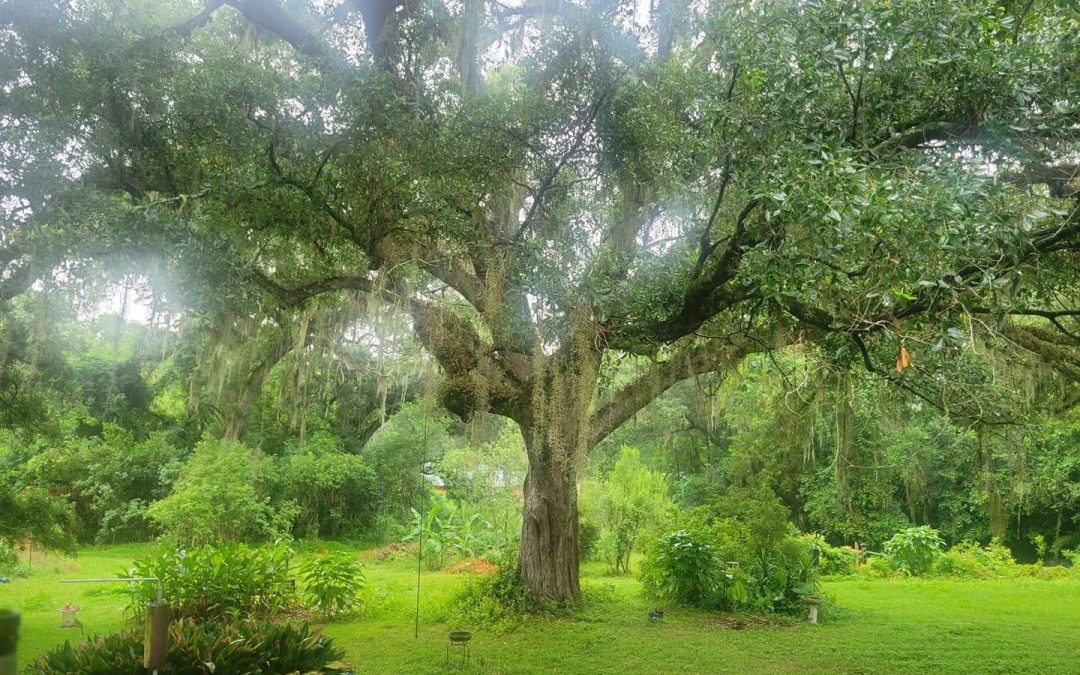
by Mark Tancig | Jun 17, 2021
Spending time outdoors during the Florida summer is not for the faint of heart. It’s hot! And it’s humid! Just moving around outside for a moment in the early morning causes you to break out in a sweat. Most evenings, even after the sun is low in the western sky, but there’s still enough light to enjoy the outdoors, the sweat doesn’t stop. A Floridian’s only hope is that nearby, there is a large shade tree to take cover under. In north Florida, there’s nothing more inviting than a huge live oak draped in Spanish moss for a drink of ice water and a slight breeze. If you don’t have such a spot, start thinking about planting a shade tree this winter!
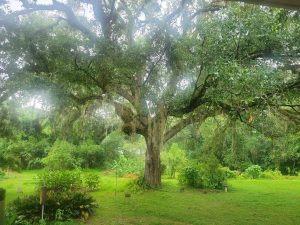
A large live oak is great for shade! Credit: Dawn Reed.
In north Florida, we have many options to choose from, as we live in an area of the United States with some of the highest native tree abundance. Making sure you get the right tree for the right place is important so make a plan. Where could this tree go? Is there plenty of space between the tree and any structures? You’ll want to give a nice shade tree plenty of room – 20’ to 60’ away from structures and/or from other large trees – to grow into a great specimen. Be sure not to place a large tree under powerlines or on top of underground infrastructure. You can “Call 811 before you dig” to help figure that out. If space is limited, you may want to consider trees that have been shown to be more resilient to tropical weather. Also try and place the tree in a way that provides added shade to your home. Deciduous trees planted along your home’s southeast to southwest exposure provide shade during the summer and let in the sun during the cooler winter. However, be careful that the tree doesn’t grow to block the sun from your vegetable garden!
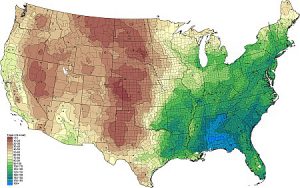
A density gradient map of native trees in the US. Notice where the highest number occur. Credit: Biota of North America Program.
Here are some ideas for shade trees, those trees that are tall (mature height greater than 50’) and cast a lot of shade (mature spread greater than 30’). All of these are native trees, which have the added benefit of providing food and shelter to native wildlife.
- Red maple (Acer rubrum)
- Pignut hickory (Carya glabra)
- Green ash (Fraxinus pennsylvanica)
- Tulip poplar (Liriodendron tulipifera)
- Southern magnolia (Magnolia grandiflora)
- Sycamore (Platanus occidentalis)
- Shumard oak (Quercus shumardii)
- Live oak (Quercus virginiana)
- American elm (Ulmus americana)
It’s best to plant during the winter and follow good planting practices.
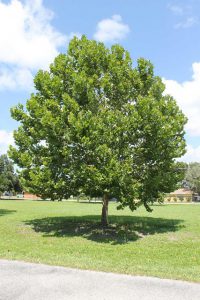
Even with this young sycamore, you’ll be made in the shade. Credit: UF/IFAS.
While it may take a while for you to relax under the shade of your tree, they can surprise you in their growth and, as they say, there’s no time like the present. If you have questions on selecting or planting shade trees, contact your local UF/IFAS Extension office.
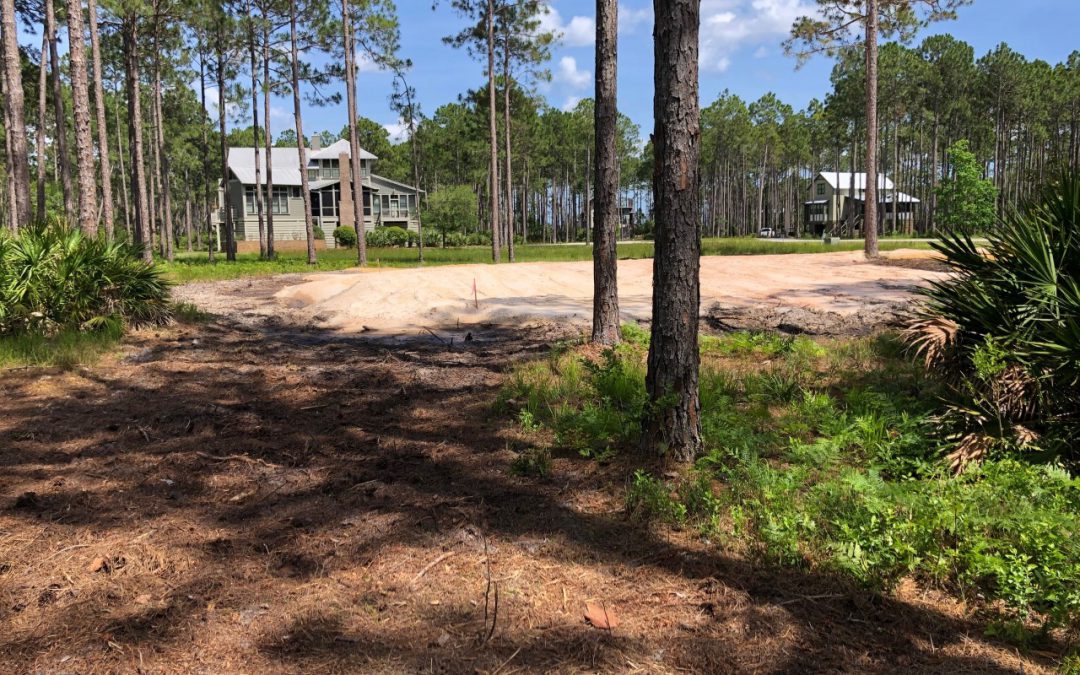
by Stephen Greer | May 27, 2021
As we have all observed communities are growing in the Panhandle through new home construction or through renovation of existing properties. This article will address new home construction. Many questions come to mind as construction begins with some of these questions needing to be addressed prior to start of construction. Determining impacts on the plant resources that already exist on the site should be included in the planning, design, construction and post-construction phases to be successful in achieving a healthy vibrant landscape for all to enjoy.
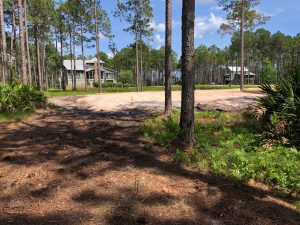
Photo Courtesy: Stephen Greer
Homes in community developments are being located on smaller lots in groups with conservation areas saved for the open spaces for all to enjoy. An older term for this was new urbanism and now is often referred to as conservation or clustered development. This type of development identifies and encourages environmentally friendly habitats for plants and animals creating a biodiversity within a walkable neighborhood designed to protect yet allow residence to enjoy some of the Northwest Florida beauty.
How can the objectives of building the new home desired, manage to protect the healthy plants already existing on the site? These challenges are difficult to answer but there are steps to accomplish both. For this article I will address construction and tree protection.
Protecting existing trees during the construction and post-construction phases takes expertise and a plan. First, consider hiring a professional arborist or urban forester to assist in this plan development. Understanding the existing trees on site prior to construction from the variety, location, visual impacts, size, overall health and location on the property are a good start. How do you protect the selected trees? First identify the trees that will need to be removed. Look for unhealthy stressed trees, significant limb death already occurring, poor crown growth (thinning) and other observations.
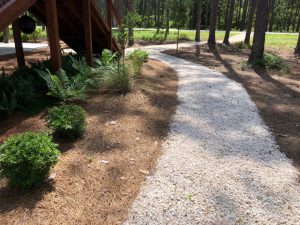
Photo Courtesy: Stephen Greer
The next step is to make a sight plan that needs to include grading needs for the home, drainage on the property, existing trees and surrounding vegetation, property lines, set back requirements, driveway location, utility placements and site of home. Flag trees that will be impacted and will need to be removed during the construction.
Following the sight plan, a tree protection plan needs to occur. This must happen before construction begins and include all parties involved to make sure all are in agreement. This is the stage where the group can identify conflicts involving tree protection and construction. Oversight by the owner, contractor and equipment operators is critical. A tree protection zone must be identified and implemented before construction. This typically involves setting up a fence around the protected trees and vegetation to restrict access of equipment and potential damage to the root system. A rule of thumb is to maintain a radius of at least 1.25 feet of protected area for each 1 inch of tree trunk diameter. An example would be a 12-inch diameter tree trunk with good protection at 15 feet to best protection at 30 feet of radius.
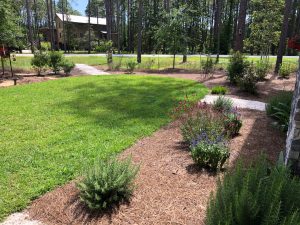
Photo Courtesy: Stephen Greer
The point is to give the best chance of a health survival of the tree during this soil and site disturbance as the construction process progress all the way to post construction with the removal of the protective fencing. Difficult decisions may need to be made of selecting trees to protect but will be needed. Enjoy the successes and plan for creating a new landscape that includes part of conserving plants that were there before and going forward.
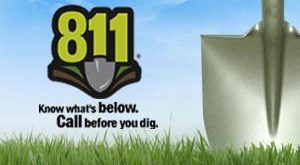
by Sheila Dunning | Apr 1, 2021
 Call 811 before you dig. No one wants a weekend project to be the cause of internet, phone and cable outages. Worse yet, what if someone gets hurt from contact with natural gas or electrical lines? That’s why it is so important to have buried utilities in the yard located and marked before digging. Sunshine 811 coordinates each individual company to clearly mark where the service lines are located. Homeowners are required by law to contact 811 three days before any soil removal is done. The service is free.
Call 811 before you dig. No one wants a weekend project to be the cause of internet, phone and cable outages. Worse yet, what if someone gets hurt from contact with natural gas or electrical lines? That’s why it is so important to have buried utilities in the yard located and marked before digging. Sunshine 811 coordinates each individual company to clearly mark where the service lines are located. Homeowners are required by law to contact 811 three days before any soil removal is done. The service is free.
Have information prepared before making the request. Describe the work to be performed (e.g. fence install, landscaping, irrigation install), including the type of equipment that will be used. Specify the exact location on the property and how long the work will continue. Finally, provide all the contact information (e.g. name, phone number, e-mail), should there be any additional questions.
Call 811 or request a single address ticket online. Receive a ticket number and wait two full business days, not counting weekends or holidays. Then contact 811 again. Make sure that all the utilities have responded in the Positive Response System (PRS). Sometimes that may mean that the company doesn’t have anything to make in the area.
If there are utility lines running through the yard, they will be marked with specifically colored paints or flags. Red is used for electrical lines, orange indicates communication lines, yellow means gas, blue is used for potable water, purple is reclaimed water, and green indicates sewer lines. White lines may be used to outline digging areas and pink are temporary survey marks. This is the APWA Uniform Color Code.
Every effort is made to locate the lines as accurately as possible. But, the safest thing to do is hand dig to expose the utility line before using any mechanized equipment. Lines can vary up to 24” from the marked line and depths can be less than 5”. Remember there may be access lines running through the property even if that service isn’t utilized at that address.
Keep safe this spring. Call 811 before digging.
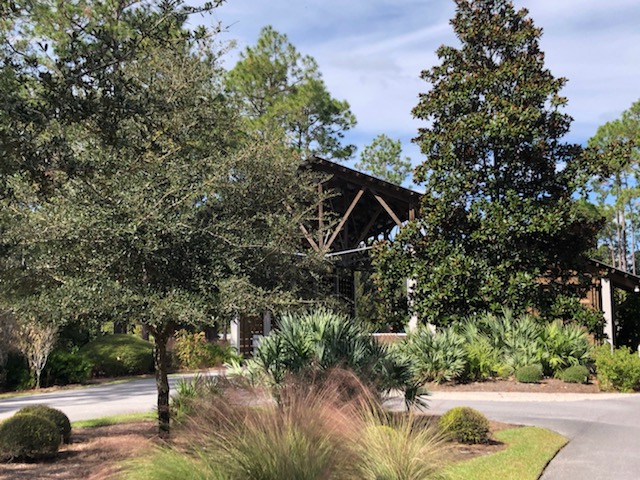
by Stephen Greer | Mar 11, 2021
Landscaping with native plants brings opportunities and challenges while adding diversity and beauty to the home. There are many factors that come into play to successfully grow plants. As gardeners, we all want things to look exceptional for all to enjoy. Native plants have evolved over long periods of time naturally in a given region without intervention, bringing much needed diversity to natural areas and landscapes. A big plus for natives are the flowers presented for the local bee populations and other pollinators assisting in the continuation of the plant species potentially established over thousands of years.
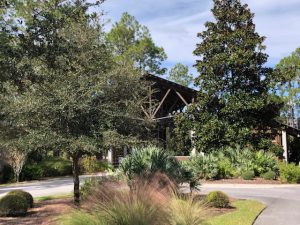
Landscape of Native Plants. Photo Credit: Stephen Greer, UF IFAS Extension Santa Rosa County
Native plants have evolved in natural communities and are found to be interdependent not only plant to plant yet with soil type, soil microbial activity through bacteria and fungus, specific site location and others though biodiversity of these living communities. Part of this community is often referred to as the soil web creating the connections of billions upon billions of organisms in the critical survival of the plants, insects and other animals we see. The first steps when considering native plants for your landscape are to do your research and contact your local Extension office. Some questions to consider may include: Does it grow best in well drained sand or wet soils or require high in organic matter? Will full sun, part-shade to full shade be needed?
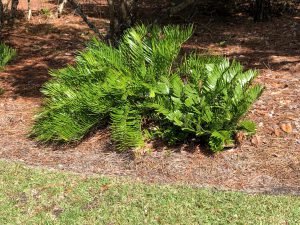
Coontie Palm in Landscape. Photo Credit: Stephen Greer, UF IFAS Extension Santa Rosa
Plants that are native and non-native are often seen in the same landscape setting. Consideration should be taken to determine if either of the groups are aggressive in expanding beyond the intended plant setting. Before moving on, non-native is in reference to plants that are introduced to a plant community that came from a totally different plant location. An example of that location being hollies from southeast Asia or South America or even a different area of the United States. Many have been researched and observed for many years under managed situations before being introduced into the local landscape nursery markets. Once in a while a plant is introduced that has not gone through a long rigorous study and can become naturalized outside of its normal plant zones and establish as an invasive species. This highly adaptable aggressive habit can, and often will colonize a given location out competing the native plants. Kudzu is a good example of an invasive exotic plant that is naturalized in the southeastern U.S.
As gardeners there are opportunities to have positive impacts on some of these diminished native habitat areas that can be threatened by growth of urban and rural areas in Florida. Establishing native plants areas into the landscape with proper soil preparation, managed water needs and more gives that chance for this interdependent system of plants, animals and nonliving elements to remain established with big impacts.
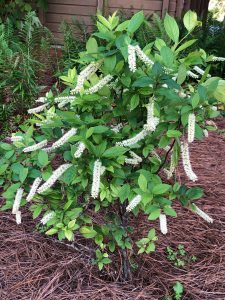
Virginia Sweetspire. Photo Credit: Stephen Greer, UF IFAS Extension Santa Rosa County
Native plants can be a working part of the garden from wonderful flowers, season color change, leaf foliage of multiple sizes and shapes to feed the insects that feed the birds, leaves and nuts that feed so many other animals for us to enjoy seeing. Balance is such a big part of being a successful gardener. Remember not all native plants are suitable for landscape spaces, do your research and ask for assistance from the experts to determine if it is the right plant for the right place.






















